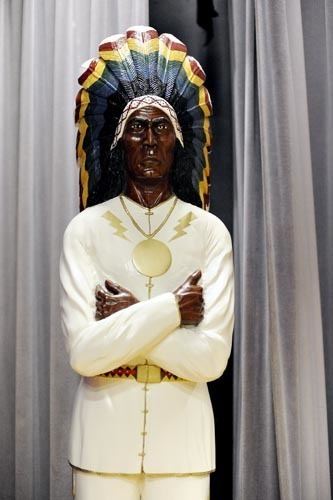Trophy Chief Caddo | Next meeting November 2017 Meetings total 52 | |
 | ||
First meeting September 14, 1957Northwestern State 20, Stephen F. Austin 7 Latest meeting November 19, 2016Stephen F. Austin 45, Northwestern State 31 | ||
Chief Caddo is the name of the statue given to the winner of the annual football game between Southland Conference members Northwestern State University (NSU) of Natchitoches, Louisiana and Stephen F. Austin State University (SFA) of Nacogdoches, Texas.
Contents
Made of solid wood, Chief Caddo is the largest trophy in college football, standing 2.3-metre (7.5 ft) and weighing in excess of 150-kilogram (330 lb).
History
The idea of the statue was created in 1960 when longtime rivals NSU and SFA decided to award the winner of the game a trophy. The two schools settled on a wooden statue (both schools are located in heavily forested areas) of a legendary Indian chief whose tribe (the Caddo) was responsible for settling the locations that became the cities in which university was located (both of which are named for branches of the tribe). Under the agreement, based on the results of the 1961 football game, the losing school would chop down a tree from one of its nearby forests, while the winning school would receive the log and carve the statue from it.
NSU won the 1961 game 35-19; thus, SFA delivered a 2,000-pound black gum log to NSU. Woodcarver Harold Green spent some 230 hours fashioning the statue. He was named Chief Caddo to honor the Indian tribe that not only settled the two communities, but provided safety for the early white settlers in the area.
In June 2010, after years of transportation to and from games had left Chief Caddo in poor condition, the trophy was given a much needed refurbishing. The project, headed by Bill Flynn (Flynn Paint & Decorating of Nacogdoches), undertook the restoration of the trophy. Among the many restorations to the trophy were: the repairing of the base, the construction and replacement of feathers in the headdress, the restaining and repainting of the entire trophy, and intricate detailing.
NSU and SFA have been playing for Chief Caddo since 1961 and NSU has a 29–15–1 advantage in the trophy game.
Currently Chief Caddo resides at Stephen F. Austin University after the Jacks beat the Demons 45–31 at Homer Bryce Stadium.
Importance of the Caddo Tribe
Historians say had it not been for the Caddo Indians, the Spanish and French colonists who came to the area would not have survived the onslaughts of Apache and Comanche warriors from the west, and the Natchez from the east. In addition, French and Spanish writers of the time said it was certain, wise Caddo chiefs made it possible for the colonists to live as neighbors while their mother countries were at war against each other.
Nacogdoches and Natchitoches both received their names from Caddo place names. In Caddo language "Na" simply means "place of." Nacogdoches is thought to mean "the place of places." Two myths exist about how the cities got their names. Both versions of the myth agree that an Indian chief with two sons sent one east and the other west, and they traveled the same distance and established villages. As for the folklore in question:
One version, as reported by historian Samuel Stewart Mims in "Rios Sabinas", credits the chief of an Adae Indian village on the Sabine River. The village was overpopulated and the chief ordered his two grown sons to report to him precisely at sunrise. He told one son to walk east and the other to walk west until the very moment of sunset. The sons were to establish a village at the place they reached. The son who went west wound up in a grove of persimmon trees, and named his village Nacogdoches, meaning persimmon. The eastbound son reached a grove of papaw trees and named his village Natchitoches, meaning papaw.
Another version says that the chief had twin sons, Nacogdoches and Natchitoches, and could not decide who would lead the tribe following his death. The chief split the tribe between them and sent each in different directions. They traveled for three days, one eastbound and one westbound, and wound up where the cities are located today.
